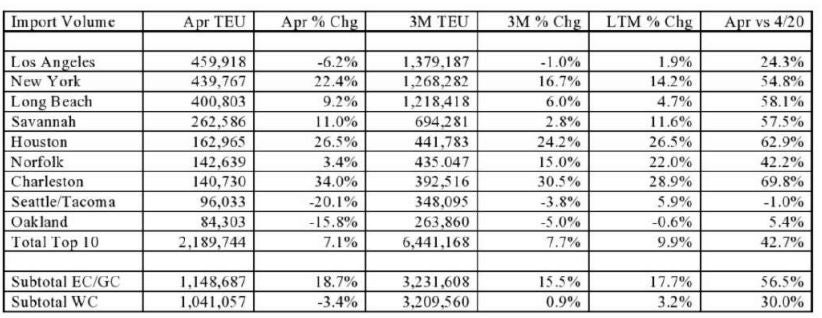“Cargo continues to move at a record-setting pace and may not slow down anytime soon,” according to Mario Cordero, executive director of the Port of Long Beach.
The port on California’s San Pedro Bay recorded its busiest April ever. Its neighbor, the Port of Los Angeles, had the second-busiest April in its history even though it posted a year-over-year cargo volume decrease. But the strongest performances in April took place at ports on the Gulf and East coasts.
The Port of Long Beach last month moved 820,718 twenty-foot equivalent units, up 10% from the previous record set in April 2021. Imports increased 9.2% year-over-year to 400,803 TEUs, while exports dipped 1.8% to 121,876 TEUs.

Empty containers moved saw the biggest increase, 16.9% year-over-year, to 298,039 TEUs.
The Port of Long Beach handled 3,281,377 TEUs during the first four months of 2022, a 5.1% increase from the same period in 2021.
Cordero said the port is not anticipating any lazy days of summer.
“We are preparing for a likely summertime surge as China recovers from an extended shutdown due to COVID-19,” he said in the port’s volumes report. “Shippers are quickly moving imports and empties from the docks, terminals are staying open longer and we are working to finalize our new Supply Chain Information Highway data-tracking solution.”
Trans-Pacific flows steady
Gene Seroka, executive director of the Port of LA, said in a press release Tuesday that trans-Pacific trade “has held steady” despite the COVID lockdowns in China.
The Port of LA handled 887,357 TEUs in April. The port’s busiest April occurred last year, when it moved 946,966 TEUs.

The more than 3.5 million TEUs moved in the first four months of 2022 at the Port of LA is 1% ahead of last year’s record pace.
The port did report declines. Loaded imports in April totaled 456,670 TEUs, a 6.8% decrease year-over-year. Loaded exports totaled 99,878 TEUs, a 12.7% decrease from April 2021.
While the number of empty containers moved at the Port of Long Beach increased by more than 15%, the Port of LA saw a 3.4% year-over-year decrease, handling 330,810 TEUs of empties.
Cordero’s statement about cargo moving at a record-setting pace is particularly applicable for ports outside California. The Georgia Ports Authority reported Tuesday that its April container volumes were up 6.2% year-over-year and that it had the third-busiest month in its history. South Carolina Ports has set cargo records for 14 consecutive months. April was the second-busiest month in the history of the Port of Virginia in Norfolk. And Port Houston reported Tuesday that it had its busiest April ever, with the 334,493 TEUs handled a 21% year-over-year increase.
McCown’s take
“The 10 largest U.S. ports saw inbound box volume grow 7.1% in April, an increase from the 3.5% gain in March but below February’s 13.7% gain,” maritime expert John McCown wrote in The McCown Report.
April’s overall inbound volume at the top 10 ports of 2,189,744 TEUs was the third-highest total ever and just 1.8% below the record 2,230,919 TEUs set just a month earlier, McCown said.
“April was the 11th straight month in which the year-over-year percent change in volume at East/Gulf Coast ports outperformed West Coast ports,” he noted. “In April, there was a 22.1 percentage-point coastal gap resulting from an 18.7% gain at East/Gulf Coast ports and a 3.4% decline at West Coast ports. This is the fourth-highest monthly gap ever in those measures and above the average 16.6 percentage-point difference over the 11-month period.”
He attributed the stronger relative performance of ports on the Gulf and East coasts to the initial pandemic volume surge disproportionately benefiting West Coast ports and impacting comparisons; shippers rerouting cargo to “avoid the widely reported congestion” in LA and Long Beach; and lower linehaul costs from the Gulf and East coasts compared to cross-country intermodal service from the West Coast.

Shanghai volume redirected
April was strong at U.S. ports because China’s total container volume was down only 2.5%, McCown pointed out.
“As a result of the lockdown in Shanghai related to a COVID variant, the Port of Shanghai, the largest container port in the world, saw a 25% reduction in its volume in April. However, with seven of the 10 largest container ports in the world in China, that volume was redirected,” he explained.
According to McCown, the U.S. ports with the strongest April performance were Charleston, South Carolina, up 34%; Houston, up 26.5%; and New York/New Jersey, up 22.4%.
“The weakest performance in April came in at Seattle/Tacoma, down 20.1%; Oakland, down 15.8%; and Los Angeles, down 6.2%,” he wrote.
McCown forecast May’s numbers “will likely show an overall decline as it will be measured against the busiest-ever month for West Coast ports in May 2021.”
Read more
- IMF: Rising ocean shipping costs to bring wave of higher prices
- Will Long Beach’s sunny spring be followed by stormy summer?
- Savannah harbor deepening is done
Click here for more American Shipper/FreightWaves stories by Senior Editor Kim Link-Wills.











